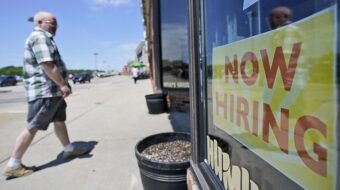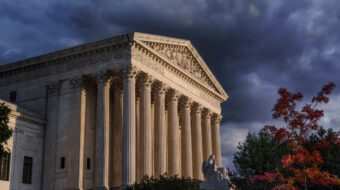While on a visit to the German Democratic Republic (GDR, or East Germany) 21 years ago, at the time of the great peace demonstrations against U.S. cruise and Pershing missiles, I learned that an East German painter would soon begin a vast panorama on the subject of the German Peasant War of the 1520s.
My curiosity aroused, I located a small book giving examples of the work of this artist, Werner Tübke. To be honest, I was not very impressed. Tübke’s graphic art obviously favored the Old Masters, and seemed old-fashioned and static. However, when I next returned to Germany in the late winter of 2003, I resolved to make an expedition to see the actual completed work in the little town of Bad Frankenhausen, located in the center of the country.
The Peasant War erupted at the time of the Reformation, when all Europe was convulsed with the currents of change. In 1517, Luther nailed his 95 Theses on the door of the church in Wittenberg, calling for reforms in Christianity.
The hierarchy of the Catholic Church soon bitterly opposed any change. Luther burnt the papal bull excommunicating him. Germany itself was divided into hundreds of small feudal realms. Some of its rulers sympathized with Luther; others took the side of Rome.
Within the Reformation, there were further political and theological divisions. A radical wing, based primarily among the peasants, but including some substantial towns, called for more thoroughgoing changes. The Twelve Articles of the peasants stipulated the end of serfdom, the election of pastors rather than appointment by a hierarchy, and the restoration of hunting, fishing and pasturage rights which were being seized by the church and the nobility.
In the spring of 1525, as many as 300,000 peasants rose up against their masters in one of the great revolts of European history. Battles occurred all through southern and central Germany, but the peasants lacked military experience, and had little coordination, while the nobles, frightened for their lives and property, were assisted by thousands of mercenaries returning from a war against the French. Some estimates of the slaughter run as high as 100,000. Whatever the actual number slain, this bloodbath cemented the authority of church and state over the people and helped shape the course of German history for the next 500 years.
Bad Frankenhausen was the site of one of the most terrible peasant defeats. Beginning in 1973, the government of the GDR started to plan a suitable panorama on the Schlachtberg (“Battle Mountain”), and eventually Werner Tübke took charge of the project. It took him 12 years to complete. It was dedicated in Sept. 14, 1989, just before the upheavals that led to the disappearance of the GDR and the unification of Germany.
One’s first impression upon entering the vast room in the cylindrical building on Battle Mountain is of dark foreboding, as there is little light, and only a few dim outlines are visible. As more visitors make their way up the stairs and the room fills, the lights are slowly turned up, revealing an astonishing spectacle 40 feet high, extending around the entire interior circumference of over 350 feet, including some 3,000 figures.
Roughly following a sequence of seasons of the year, there is a sweep of majestic scenes, culminating in an enormous section of the Bad Frankenhausen battle. There is no remnant of the static quality of Tübke’s painting years before. One section illustrates nothing less than the creation of the world in a swirl of movement, similar to the murals of Diego Rivera or especially David Siqueiros in Mexico. Another scene shows an opulent figure floating in mid-air: it’s the Pope, with the ears of a jackass. Yet another shows Luther as a Janus figure, with one face gazing back toward a crucifixion, and the other forward to a burning decree excommunicating him. There are multiple allusions to classic European paintings of the Tower of Babel, the Sphere of the Created World, and medieval punishments such as breaking on the wheel. There is a powerful element of satire at work here, as when bishops and cardinals play a friendly game of dice with aristocrats.
The main battle scene depicts at its center the revolutionary leader Thomas Müntzer, whose anguished face reflects his realization that the revolt is doomed. Shortly after the battle, he was captured, tortured and beheaded. Yet for all the chaos of his times, there he is, immortalized in this great painting.
This magnificent work is nothing less than the Sistine Chapel of European socialist art. During a period when the socialist and progressive heritage of Germany has been under assault for 15 years, it is encouraging that this monument remains unscathed. I asked at the information desk how many people had visited it since 1989, and was told: 2 million.
There are comprehensive sets of slides, books and posters of his work available via the museum’s web site: www.panorama-museum.de, or by writing the Panorama Museum, Am Schlachtberg 9, Bad Frankenhausen D-06567, Germany.
Werner Tübke died in Leipzig this past May after a long illness. He was 74.
Fred Whitehead, who lives in Kansas City, Kan., has published extensively on Midwestern cultural history. He can be reached at











Comments